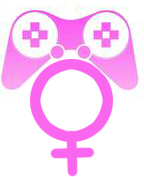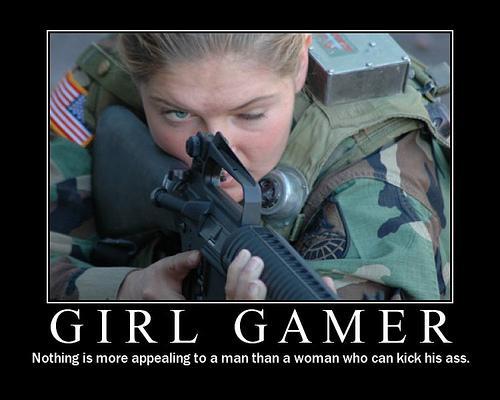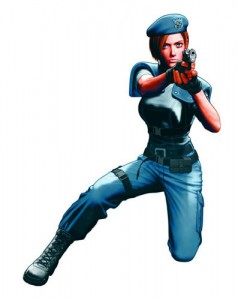Powet Alphabet – W is for Women in Gaming
by Sindra, filed in Games, Powet Alphabet on Dec.05, 2009
 Since the alphabet is the building block of our language, the Powet Alphabet is the building block of what makes us geeks.
Since the alphabet is the building block of our language, the Powet Alphabet is the building block of what makes us geeks.
Since the dawn of time, there have been gender roles in the society of mankind. I could go into a huge explanation of this basis, but if you took any history lesson in your life, you already know the basics. In short, there have always been things that have been either strictly for guys, or strictly for girls. For the longest time there were these gender roles with very little overlap. Video games were, and have been, one such area.
Video games began as a mean of entertainment, created by the geek community for the geek community. While arcade games got more exposure to a wider variety of people due to their being placed in most public hot-spots of the 70’s and 80’s, the home consoles of the mid-to-late 1980’s were isolated to those who could afford them or were more apt to staying in for their means of amusement. These were mostly teen-aged male geeks and children whose parents bought them the early game consoles. There began the stereotype that video games were either for guys or for kids, as these were the heavy demographic, and thus game developers geared these games towards those parties.

From a time period between the late 1980’s to the mid 1990’s and even into the early 2000’s, female gamers were a rarity. This is due to the games released being advocated for males more than anything. From Final Fantasy with being geared towards the D&D-type crowd, and Mortal Kombat and Street Fighter being aimed at adrenaline enthusiasts, all the way down to the Mario and Kirby franchises being made for the casual adventurous type, video games were doing what they were made for – grabbing the target audience of guys and kids. The rare female gamers were few and far between until the late 1990’s. This is due to the fact that the kids that had played these games during the late 80’s and early 90’s were now a bit older and were separated from the “Children” group to the “Young Adult” group, where genders made more of an impact on statistics. Where girl gamers were treated with mystery and sometimes dismissed altogether as being myth (U know. Leik on teh Interwebz), by the year 2000, female gamers were becoming more common and more public, with game developers now realizing that the demographic percentages had shifted.
Now game developers were scrambling to take advantage of this (seemingly) new target audience. This began with appeal. While there had previously been strong female characters in a good handful of game series, the most notable of which was Samus of Metroid, but also the women featured in the Mortal Kombat and other fighting games, they were placed into games for the sake of balancing the sexes, and for male eye candy. The majority of females that appeared in games were the secondary non-playable roles used for villain fodder.  With the introduction of more girl gamers into the mix, more strong female roles in games began emerging. Towards the end of the 90’s, in games like Final Fantasy VII, you had the badass fighter Tifa, the pacifist supportive Aeris, and the spunky adventurous Yuffie. This filled the roles of strong female characters that appealed to male and female demographics with a variety of female archetypes, rather than having one archetype and needing to stick with it regardless of whether it was a supportive or active role. Resident Evil sported the options of Jill Valentine and Claire Redfield in their first 4 games as balanced female playable characters that have since become icons for the series. In more recent games, even females who’d previous played the roles of the “damsel in distress” such as Princess Peach or Princess Zelda, are developing strong character personalities to be used in their respective games, or getting their own games altogether. (Peach got her own game and Zelda’s Shiek persona lead to her being inserted into two Super Smash Bros. games)
With the introduction of more girl gamers into the mix, more strong female roles in games began emerging. Towards the end of the 90’s, in games like Final Fantasy VII, you had the badass fighter Tifa, the pacifist supportive Aeris, and the spunky adventurous Yuffie. This filled the roles of strong female characters that appealed to male and female demographics with a variety of female archetypes, rather than having one archetype and needing to stick with it regardless of whether it was a supportive or active role. Resident Evil sported the options of Jill Valentine and Claire Redfield in their first 4 games as balanced female playable characters that have since become icons for the series. In more recent games, even females who’d previous played the roles of the “damsel in distress” such as Princess Peach or Princess Zelda, are developing strong character personalities to be used in their respective games, or getting their own games altogether. (Peach got her own game and Zelda’s Shiek persona lead to her being inserted into two Super Smash Bros. games)
 Regardless of whether or not this actually enticed female gamers to pick up these games or not, it’s become quite clear that game developers have been making the effort to make games more appealing to women. Though on the flip side, you also get games like “Cooking Mama” and “Nintendogs”, meant to appeal to girl gamers, which to me just seem kind of insulting due to gender stereotyping. That might just be me and the inherent feminist tics that all women have.
Regardless of whether or not this actually enticed female gamers to pick up these games or not, it’s become quite clear that game developers have been making the effort to make games more appealing to women. Though on the flip side, you also get games like “Cooking Mama” and “Nintendogs”, meant to appeal to girl gamers, which to me just seem kind of insulting due to gender stereotyping. That might just be me and the inherent feminist tics that all women have.


 PS3
PS3
 Famicom Dojo
Famicom Dojo KEEP PLAYING
KEEP PLAYING KEEP PLAYING: Rewind
KEEP PLAYING: Rewind Powet Toys
Powet Toys Powetcast
Powetcast Hitchhiker's Guide POWETcast
Hitchhiker's Guide POWETcast














